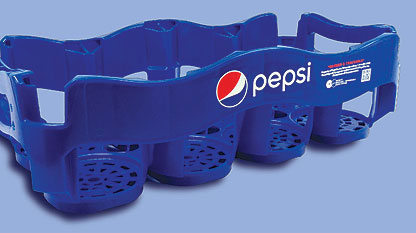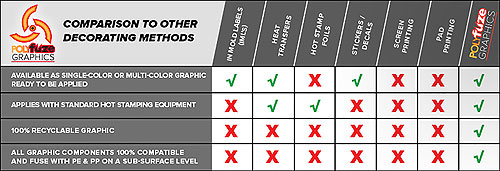Polyethylene Fuzed Graphics Enter the Market
by Marty Mares
Polyfuze Graphics Corp.
Throughout the history of the plastics decorating industry, there have been a limited number of ways to decorate polyethylene (PE), polypropylene (PP) and other olefin-based products. These methods include in-mold labels (IMLs), foils, heat transfers, stickers, screen printing and pad printing. All of these methods are susceptible to removal, wear and fading over time following prolonged exposure to the environment.
Another challenge associated with traditional plastics decorating methods is scrap rate – in some cases, scrap rate can be as high as 20 percent. Cost associated with robotics for IMLs is a further challenge that has plagued plastic decorating companies.
A new category for decorating injection-molded polyolefins has been developed called "Polyethylene Fuzed Graphics" – also known as Polyfuze. Polyfuze addresses the above-mentioned challenges and is distinctly different from other plastic decorating methods in a variety of ways.
How does molecular structure differ?
The most distinct difference lies at the heart of the technology. Polyethylene Fuzed Graphics are polymer-based instead of traditional ink. Instead of attempting to "stick" to the surface of polyethylene or polypropylene, Polyethylene Fuzed Graphics literally "fuse" into injection molded polyethylene and polypropylene. This process involves heating a PE or PP part and special graphic simultaneously, then pressing them together. The two pieces will then cool together to form a single permanent welded bond. The process works and is being used by many companies for a wide range of product applications, including rollout carts in the waste management industry, warning labels for shopping carts and a variety of reusable packaging containers.
What are the heat, time and pressure requirements?
Polyethylene Fuzed Graphics use standard hot stamp machinery. However, the heat, time and pressure for application is very different from traditional methods. The Polyfuze graphic requires 450F on the silicone die face. Operators will set the machine at 550F in order to accomplish this task (due to the nature of silicone). Although the heat required for the application process is dramatically higher, a similar dwell times of around 0.5 seconds is seen, depending on the material used for the part. Pressure requirements are significantly less. Where hot stamp foil require 400psi, the Polyethylene Fuzed Graphics require just 75psi. This allows a much larger graphic to be applied with a smaller tonnage hot stamp machine.
How is durability enhanced?
Beyond having a unique composition and differences related to application, the most distinguishing characteristic of this new technology is its ability to withstand removal and typical degeneration from injection-molded polyethylene and polypropylene. To claim the new Polyfuze graphic application is 100-percent permanent, the manufacturer has invested extensive time to compile data to support its claim.
Polyfuze Graphic Test Summary
- Tape Test D3359-09 Crosshatch: 100% Passed Tape Test
- QUV Accelerated Weatherometer Test: 2,000 hour cycle, 8 hour 70°C (158°F) with an Irradiance of 1.4 hours at 50°C (122°F) condensation: 100% Passed Tape Test
- Heat Test at 77°C (170°F) for 120 hours: 100% Passed Tape Test
- Low Temperature Impact Resistance Test: 10 lbs. at -40°C (-40°F): 100% Passed Tape Test
- Flex Test: 240 hours of continuous flexing at 21°C (70°F): 100% Passed Tape Test
- Heat Cycle Test: 2 hours at -40°C (-40°F), 2 hours at 77°C (170°F): 100% Passed Tape Test
- Pressure Wash Test: 3 minutes at 1,200 psi, 49°C (120°F) maximum temperature, 90 degree nozzle angle at six-inch distance: 100% Passed Tape Test
- Chemical Test: 21°C (70°F).
| Polyfuze Graphic Chemical Test Results | ||
| Type | Time Hours | Tape Test Result |
| Gasoline | 168 | 100% Passed |
| Diesel Fuel | 168 | 100% Passed |
| 2 Cycle Engine Oil | 168 | 100% Passed |
| Lacquer Thinner | 168 | 100% Passed |
| Brake Fluid | 168 | 100% Passed |
| Turpentine | 168 | 100% Passed |
| Kerosene | 168 | 100% Passed |
| Muriatic Acid 20 Baume 31.45% | 168 | 100% Passed |
| Alkali Solution (pH 13) | 168 | 100% Passed |
| Salt Water | 720 | 100% Passed |
| Water Immersion | 720 | 100% Passed |
A summary of the test results above supports unsurpassed graphic durability. In the years ahead, however, the technology of Polyethylene Fuzed Graphics could require plastic decorators to revisit testing standards which were developed for "topical" application methods that use adhesives, substrates and clear coats. Since Polyethylene Fuzed Graphics "fuse" to become one with injection molded PE or PP parts, they technically are not a "topical" graphic application method.
What applications are appropriate for these graphics?
Many companies today are looking for business solutions and methods that are environmentally friendly, while providing for growth and profit in the future. Decorating polyethylene, polypropylene and other olefin resins is an important part of the plastics industry for very specific reasons. These include warning labels that thwart theft and instruct of dangers; logos that give brand identity and define quality and differentiation; instructional labels that direct a consumer on the proper use of a product; and barcode, QR and data matrix codes that provide tracking and stocking information. However, the only way these types of labels have the ability to do their job is if they remain intact for the life of the product.
Current labeling methods commonly fade or can be completely removed by various outdoor elements, such as extreme cold or heat, overexposure to sunlight and weather conditions. They also are removed by daily uses including vigorous rubbing or abrasion, daily wear and tear to the product and daily contact with necessary cleaning solutions. Physical removal by pressure washing or heavy solvents and chemicals also are factors in the durability and life of these labels. These label failures account for considerable loss of money, time and valuable resources. This also means loss of vital information and identification that affects traceability and asset management. In the case of warning and informative labels, this can lead to litigation.
Rather than the reformulation of old technology, new decorating methods are needed to address all of the issues listed. The technology behind Polyethylene Fuzed Graphics is more than a new and improved adhesive or a special clear coat. It provides a permanent solution in the decorating process of olefin products.
Is the graphic recyclable?
As companies seek methods of plastic decorating to improve long-term performance and lower costs, itís also important to understand that the application process associated with Polyethylene Fuzed Graphics produces very little scrap. In the event that a PE or PP part reaches the end of its life cycle, the Polyfuze graphic is able to be recycled along with the part because it is virtually all the same material.


